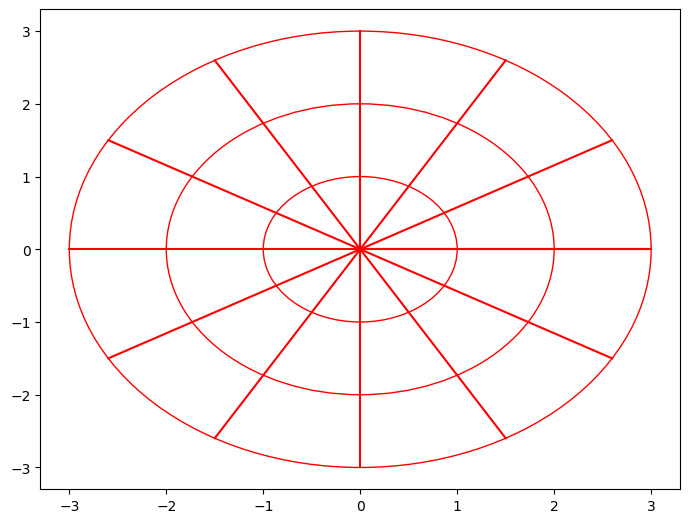
While over the past three articles, we’ve seen that double integration over cartesian coordinates is a useful and powerful tool, sometimes these integrals can be difficult to evaluate in their cartesian form. Integrating in polar coordinates by converting a cartesian double integral to its polar form or simply expressing the problem in terms of polar coordinates. Typically, integrals are defined as sums of rectangles, but this makes less sense when looking at polar regions. Let’s look at one:
# diagram of a circle with some polar rectangles
from matplotlib import pyplot, patches
import math
fig = pyplot.figure()
ax = fig.add_axes([0,0,1,1])
circle = patches.Circle((0,0), radius=3, linewidth=1, edgecolor='r', facecolor='none')
innerCircle1 = patches.Circle((0,0), radius=2, linewidth=1, edgecolor='r', facecolor='none')
innerCircle2 = patches.Circle((0,0), radius=1, linewidth=1, edgecolor='r', facecolor='none')
ax.add_patch(circle)
ax.add_patch(innerCircle1)
ax.add_patch(innerCircle2)
for angle in range(0,361,30):
ax.plot([0,3*math.cos(math.radians(angle))],[0,3*math.sin(math.radians(angle))], color='r')
Each of the small regions in the diagram above has some of the properties of a rectangle, namely the distance from the origin of the top and bottom curves being constant, and the angle between the lines making up the sides also being constant. Given these objects are somewhat analogous to rectangles in polar coordinates, we call them polar rectangles. Let’s start by finding the area of a polar rectangle. We’re calling a portion of a circle (eg the portion from x degrees to y degrees) a wedge. Consider the following diagram of a full wedge separated into polar rectangles:
# diagram of a single wedge with contained polar rectangles marked
fig = pyplot.figure()
ax = fig.add_axes([0,0,1,1])
arc1 = patches.Arc((0,0), 6, 6, theta1=60, theta2=120, edgecolor='r')
arc2 = patches.Arc((0,0), 4, 4, theta1=60, theta2=120, edgecolor='r')
arc3 = patches.Arc((0,0), 2, 2, theta1=60, theta2=120, edgecolor='r')
for i in range(1,4,1):
for angle in [60,120]:
startX = (i - 1) * math.cos(math.radians(angle))
endX = i * math.cos(math.radians(angle))
startY = (i - 1) * math.sin(math.radians(angle))
endY = i * math.sin(math.radians(angle))
ax.plot([startX, endX], [startY, endY], color='r')
ax.add_patch(arc1)
ax.add_patch(arc2)
ax.add_patch(arc3)
ax.text(0, 1.5, "The polar rectangle we want", horizontalalignment="center")
ax.text(math.cos(math.radians(60)) + 0.1, math.sin(math.radians(60)), "r1")
ax.text(2 * math.cos(math.radians(60)) + 0.1, 2 * math.sin(math.radians(60)), "r2")
ax.plot(0,0)
pyplot.show()
As seen in the diagram, if we take the area of the whole wedge and
then subtract from that the area of the inner wedge, we will get the
area of the polar rectangle that we want:
Let’s try and find the volume between the XY plane and the function
Similar to how we can use double integrals over 2D cartesian space to
calculate area, we can calulate area using double polar integrals in a
similar manner. If we hold
To show that this formula is consistent with all previous volume
formulas, we will consider the case of the volume of a circle. We know
that it is
Sometimes it can be extremely difficult (or basically impossible) to
evaluate an integral over cartesian space, but feasible to evaluate over
polar space. This means that converting an integral from cartesian space
to polar space is a useful technique. This can be done noting that
As an example, let’s look at the following integral over the unit
circle in the first and second quadrants: